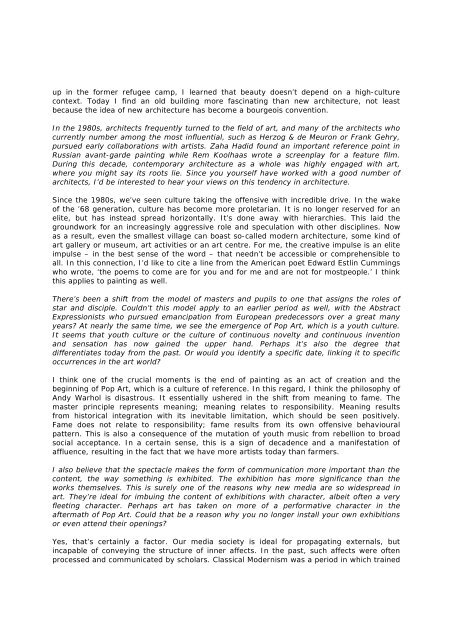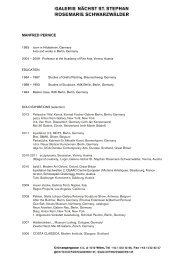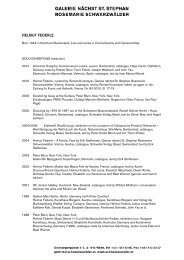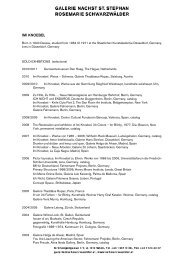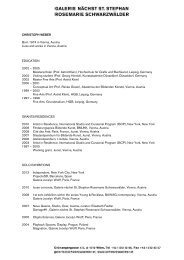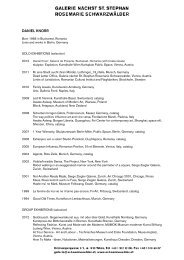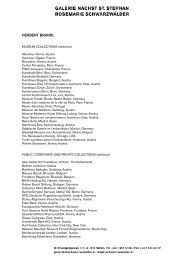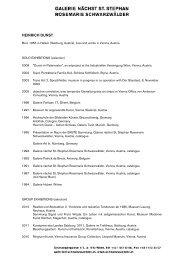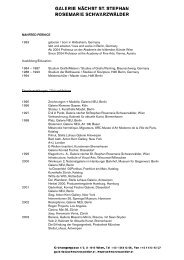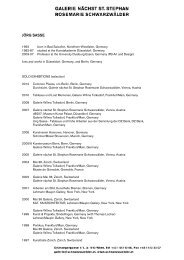Helmut Federle in conversation with Christian Kerez
Helmut Federle in conversation with Christian Kerez
Helmut Federle in conversation with Christian Kerez
You also want an ePaper? Increase the reach of your titles
YUMPU automatically turns print PDFs into web optimized ePapers that Google loves.
up <strong>in</strong> the former refugee camp, I learned that beauty doesn’t depend on a high-culture<br />
context. Today I f<strong>in</strong>d an old build<strong>in</strong>g more fasc<strong>in</strong>at<strong>in</strong>g than new architecture, not least<br />
because the idea of new architecture has become a bourgeois convention.<br />
In the 1980s, architects frequently turned to the field of art, and many of the architects who<br />
currently number among the most <strong>in</strong>fluential, such as Herzog & de Meuron or Frank Gehry,<br />
pursued early collaborations <strong>with</strong> artists. Zaha Hadid found an important reference po<strong>in</strong>t <strong>in</strong><br />
Russian avant-garde pa<strong>in</strong>t<strong>in</strong>g while Rem Koolhaas wrote a screenplay for a feature film.<br />
Dur<strong>in</strong>g this decade, contemporary architecture as a whole was highly engaged <strong>with</strong> art,<br />
where you might say its roots lie. S<strong>in</strong>ce you yourself have worked <strong>with</strong> a good number of<br />
architects, I’d be <strong>in</strong>terested to hear your views on this tendency <strong>in</strong> architecture.<br />
S<strong>in</strong>ce the 1980s, we’ve seen culture tak<strong>in</strong>g the offensive <strong>with</strong> <strong>in</strong>credible drive. In the wake<br />
of the ’68 generation, culture has become more proletarian. It is no longer reserved for an<br />
elite, but has <strong>in</strong>stead spread horizontally. It’s done away <strong>with</strong> hierarchies. This laid the<br />
groundwork for an <strong>in</strong>creas<strong>in</strong>gly aggressive role and speculation <strong>with</strong> other discipl<strong>in</strong>es. Now<br />
as a result, even the smallest village can boast so-called modern architecture, some k<strong>in</strong>d of<br />
art gallery or museum, art activities or an art centre. For me, the creative impulse is an elite<br />
impulse – <strong>in</strong> the best sense of the word – that needn’t be accessible or comprehensible to<br />
all. In this connection, I’d like to cite a l<strong>in</strong>e from the American poet Edward Estl<strong>in</strong> Cumm<strong>in</strong>gs<br />
who wrote, ‘the poems to come are for you and for me and are not for mostpeople.’ I th<strong>in</strong>k<br />
this applies to pa<strong>in</strong>t<strong>in</strong>g as well.<br />
There’s been a shift from the model of masters and pupils to one that assigns the roles of<br />
star and disciple. Couldn’t this model apply to an earlier period as well, <strong>with</strong> the Abstract<br />
Expressionists who pursued emancipation from European predecessors over a great many<br />
years? At nearly the same time, we see the emergence of Pop Art, which is a youth culture.<br />
It seems that youth culture or the culture of cont<strong>in</strong>uous novelty and cont<strong>in</strong>uous <strong>in</strong>vention<br />
and sensation has now ga<strong>in</strong>ed the upper hand. Perhaps it’s also the degree that<br />
differentiates today from the past. Or would you identify a specific date, l<strong>in</strong>k<strong>in</strong>g it to specific<br />
occurrences <strong>in</strong> the art world?<br />
I th<strong>in</strong>k one of the crucial moments is the end of pa<strong>in</strong>t<strong>in</strong>g as an act of creation and the<br />
beg<strong>in</strong>n<strong>in</strong>g of Pop Art, which is a culture of reference. In this regard, I th<strong>in</strong>k the philosophy of<br />
Andy Warhol is disastrous. It essentially ushered <strong>in</strong> the shift from mean<strong>in</strong>g to fame. The<br />
master pr<strong>in</strong>ciple represents mean<strong>in</strong>g; mean<strong>in</strong>g relates to responsibility. Mean<strong>in</strong>g results<br />
from historical <strong>in</strong>tegration <strong>with</strong> its <strong>in</strong>evitable limitation, which should be seen positively.<br />
Fame does not relate to responsibility; fame results from its own offensive behavioural<br />
pattern. This is also a consequence of the mutation of youth music from rebellion to broad<br />
social acceptance. In a certa<strong>in</strong> sense, this is a sign of decadence and a manifestation of<br />
affluence, result<strong>in</strong>g <strong>in</strong> the fact that we have more artists today than farmers.<br />
I also believe that the spectacle makes the form of communication more important than the<br />
content, the way someth<strong>in</strong>g is exhibited. The exhibition has more significance than the<br />
works themselves. This is surely one of the reasons why new media are so widespread <strong>in</strong><br />
art. They’re ideal for imbu<strong>in</strong>g the content of exhibitions <strong>with</strong> character, albeit often a very<br />
fleet<strong>in</strong>g character. Perhaps art has taken on more of a performative character <strong>in</strong> the<br />
aftermath of Pop Art. Could that be a reason why you no longer <strong>in</strong>stall your own exhibitions<br />
or even attend their open<strong>in</strong>gs?<br />
Yes, that’s certa<strong>in</strong>ly a factor. Our media society is ideal for propagat<strong>in</strong>g externals, but<br />
<strong>in</strong>capable of convey<strong>in</strong>g the structure of <strong>in</strong>ner affects. In the past, such affects were often<br />
processed and communicated by scholars. Classical Modernism was a period <strong>in</strong> which tra<strong>in</strong>ed


